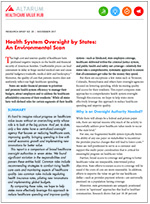Improving Value
State Accountability for Healthcare Value
Excess healthcare spending crowds out other important purchases and burdens individuals, employers and governments. Getting to better healthcare value is critical to reaching our nation’s goal of reducing disparities and achieving broad access to a high quality, patient-centered healthcare system.
States are a key actor that needs to be at the forefront of meaningful progress on healthcare cost and value issues. As regulators and payers, state governments already play a critical role in how health systems function but few states take a coordinated, systematic approach to ensuring that all residents get value for their healthcare dollar, things like addressing excessive prices, coordination failures, and ensuring coverage and care is affordable for consumers.
|
For several reasons, states need to take on a comprehensive and systematic oversight role.
-
Evidence is strong that market forces alone will not produce a high functioning, patient-centered healthcare system. For example, most hospital markets in the US are high consolidated (leading to excess prices) and physicians are often not practicing where they are needed.
-
Addressing healthcare value problems requires solutions that are customized to a state’s unique population and local market conditions.
-
Polling data show that residents on both sides of the political aisle strongly wish for states to play this oversight role.
Moreover, our fragmented health system typically limits the ability of any one payer or stakeholder to incentivize the provider practice changes that will lead to lower costs, better quality and the types of investments needed at the population level. States are well positioned to:
-
Serve as a convener
-
Support multi-payer coordination
-
Invest in "upstream" approaches that lead to healthier communities
To act as informed stewards of the state healthcare system, a state should:
-
Create a central oversight authority that uses evidence to address excessive pricing, unwarranted quality variation, health inequities and ensuring that spending moves upstream when merited. Given the intertwined nature of healthcare delivery systems, this entity should broadly consider ALL spending and all forms of health delivery in the state, not just selected coverage types.
-
Add critical data and analysis capacity to support the deliberations of this oversight authority.
-
An Office of the Healthcare Advocate to centralize assistance for consumers trying to navigate their coverage problems and to ensure that a comprehensive understanding of the consumer experience informs the recommendations of the oversight authority.
While not required, all these functions can be housed in the same independent agency or quasi-public entity. The materials above include case study examples from several states providing proof-of-concept. Finally, our roadmap to evidenced-based solutions shows states how to address specific problems that might be identified by the oversight authority, problems like: excessive prices, over-provision of low value care, under-provision of high value care, coordination failures, failure to address the personal and social determinants of health, and failure to ensure coverage and care are affordable.
-
Convening Report: State Accountability for Healthcare: A Report from a Convening of Healthcare Experts
-
Research Brief No. 15: Measuring Healthcare Value at the State Level: A Call to Action
-
Research Brief No. 14: Measuring Healthcare Value at the State Level: Advocates' Guide
-
“Statewide Payment and Delivery Reform: Do States Have What It Takes,” Journal of Health Politics, Policy and Law (Dec 2017)
-
Variation In Health Outcomes: The Role Of Spending On Social Services, Public Health, And Health Care – Health Affairs (2016)
-
Enlisting States as Partners in Healthcare Cost Savings (2014).
-
Lessons from High- and Low- Performing States for Raising Overall Health Systems Performance - The Commonwealth Fund (2011).
-
Hub Webinar (December 2017)
The Value of State Health System Oversight Entities -
HUB Webinar (April 2017)
State Accountability for Healthcare







